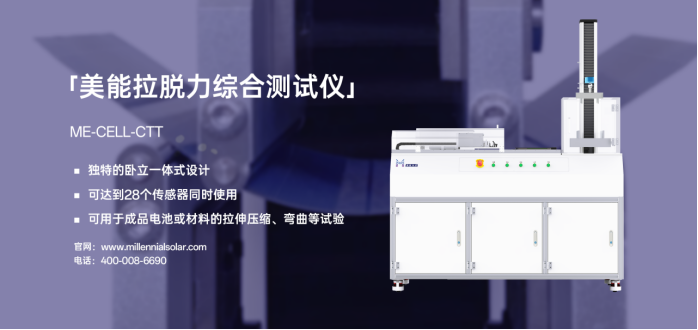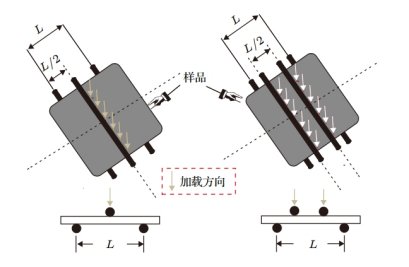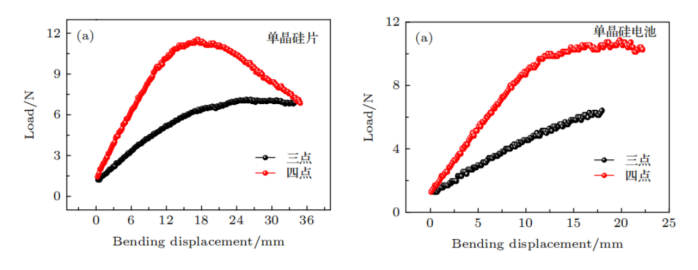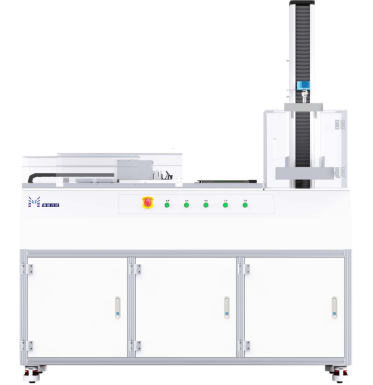
量子效率测试仪
PL/EL一体机
Sinton硅片少子寿命测试仪
Sinton硅块少子寿命测试仪
绒面反射率测试仪
3D共聚焦显微镜
清洗制绒工作站
在线四探针方阻测试仪
全自动扫描四探针方阻测试仪
在线薄膜厚度测试仪
晶化率测试仪
Horiba高速高分辨显微共焦拉曼光谱仪
傅里叶红外光谱仪
霍尔效应测试仪
分光光度计
全光谱椭偏仪
Horiba椭圆偏振光谱仪
TLM接触电阻率测试仪
超景深显微镜
网版智能影像测量仪
全自动影像测量仪
卧式拉力机
电池片稳态光衰老化试验箱
电池片紫外老化试验箱
电池片拉脱力综合测试仪
外观检验台
湿漏电测试系统
组件实验室EL测试仪
紫外老化试验箱
稳态光衰老化试验箱
电流连续性监测系统
PID测试系统
旁路二极管测试系统
LeTID测试系统
反向电流过载系统
脉冲电压测试系统
绝缘耐压测试仪
接地连续性测试仪
绝缘耐压接地测试仪
湿热环境试验箱
湿冻环境试验箱
热循环试验箱
动态机械载荷测试机
静态机械载荷测试机
冰雹冲击试验机
引出端强度试验机
霰弹冲击试验机
抗划伤(切割)测试机
剥离试验机
万能材料试验机(单臂)
万能材料试验机(双臂)
光伏玻璃透过率测试仪
醋酸测试试验箱
交联度测试系统
二极管接线盒综合测试仪
落球冲击试验机
半自动四探针
全自动探针式台阶仪
复合式LED模拟器
多通道太阳能MPPT系统
LED模拟器光浴
Horiba高灵敏一体式稳瞬态荧光光谱仪
钙钛矿P1激光划线测试仪
钙钛矿在线膜厚测试仪
钙钛矿工艺检测工作站
手持式IV测试仪
便携式EL测试仪
手持热成像测试仪
户外组件IV测试仪
户外组件多通道测试系统
光伏逆变器电能质量测试仪
无人机EL检测仪
太阳能电池 | 三点与四点弯曲试验对比分析
日期:2024-08-07
硅片的易碎性已成为制约太阳电池性能发挥、寿命延长及生产效益提升的关键因素。鉴于此,在晶硅光伏领域,追求高效能输出与成本优化的同时,将晶体硅的机械强度与韧性视为一项不可或缺的核心考量指标。其中,三点弯曲与四点弯曲试验尤为关键。「美能光伏」拉脱力综合测试仪,同时兼具卧式 180° 剥离强度测试和立式电池片弯曲测试。

太阳能电池片的设计与生产过程中,质量与稳定性是其核心考量。为确保产品能在复杂多变的环境条件下长期稳定运行,一系列严格的测试和验证不可或缺,其中,三点弯曲与四点弯曲试验尤为关键。
弯曲试验对比
根据具体需求,可采用三点弯曲或四点弯曲两种不同的加载方式。三点弯曲法通过在样品上方施加一个集中力,使其在两个固定支撑点之间发生弯曲变形。而四点弯曲法则在样品上方增设一个支撑点,形成更为均匀的应力分布。
三点弯曲和四点弯曲测试样片受力情况及参数如下图所示。通过弯曲强度测试仪测得载荷与位移的关系曲线, 计算得出样片的断裂强度。

测试示意图 (左) 三点弯曲 (右) 四点弯曲
弯曲试验下的机械性能
利用三点弯曲和四点弯曲测试法分别测试了两组样片:单晶硅片、双面电的机械性能, 弯曲载荷与弯曲位移的变化曲线。

(左) 单晶硅片的载荷与位移的变化曲线 (右) 双面电池的载荷与位移的变化曲线
单晶硅片,四点弯曲测试法所得弯曲载荷与弯曲位移的变化曲线的斜率和伸展幅度都高于三点弯曲测试法。虽然两种测试法所得的破碎载荷和最大弯曲位移相差不大,均在 6.87 N 和 34.76 mm,但四点弯曲测试法所得的单晶硅片承受的最大载荷为11.55 N,高于三点弯曲测试的最大载荷6.87 N。
双面电池,三点弯曲测试法测得的最大载荷和破碎载荷一致,均为 6.46 N,最大弯曲位移为 17.9 mm, 而四点弯曲测试法测得的最大载荷为10.85 N,破碎载荷为 10.24 N,最大弯曲位移是22.24 mm,两种测试方法测得的结果存在较大的差异。
弯曲试验对比分析

对于单晶硅片而言,四点弯曲测试相较于三点弯曲测试展现出了明显的优势。四点弯曲测试下的最大弯曲位移离散度较小,意味着测量结果更为稳定,重复性更高。同时,硅片在四点弯曲测试中能够承受的最大载荷显著增大,这直接反映了硅片在更均匀应力分布下的相对承载能力得到了增强。
对于双面电池而言,由于存在金属电极栅线, 两种测试方式下的最大弯曲位移测量结果离散程度相差不大,但四点弯曲测试方法同样增强了电池片的承载能力。所以,四点弯曲测试相对于三点弯曲测试方法来说, 结果更为精确, 重复性更高。
美能拉脱力综合测试仪

联系电话:400 008 6690
美能拉脱力综合测试仪ME-CELL-CTT根据光伏行业研发的,专用于光伏行业硅晶片、硅料、电池组件等相关产品的剥离力、抗拉强度等测试的专用测试设备。本设备为卧立式一体电池片测试仪同时兼具卧式 180° 剥离强度测试和立式电池片弯曲测试。
√ 卧式测试模块可达到28个传感器同时使用
√ 立式测试模块可用于成品电池或材料的拉伸压缩、弯曲等试验
√ 符合CB/T16491-2009,CB/T16491-96与JB/T17797-95 国家标准。
三点弯曲和四点弯曲试验各有其独特的优势和局限性。在实际应用中,应根据具体需求和材料特性选择合适的试验方法。「美能光伏」拉脱力综合测试仪,兼具既能做弯曲测试,又可对电池片进行焊带剥离强度测试从布达到评估电池片力学性能的目的。






































































